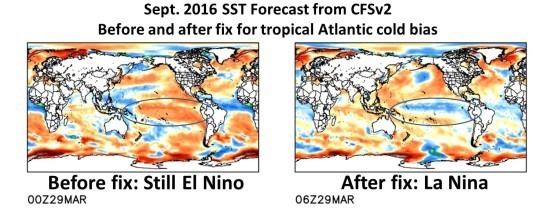As discussed over at WUWT, there has been a significant change in NOAA’s Climate Forecast System (CFSv2) model resulting from a cold bias that has been developing in the model in the tropical Atlantic ocean temperatures.
Since the NOAA presentation regarding the CFSv2 model problem made it sound like they haven’t been routinely adding ocean observations to the model, I asked NOAA’s David Behringer for clarification, and he said:
“First, to be clear, the ocean component of the CFSv2 is routinely updated with the thousands of ocean observations provided daily by many platforms (Argo drifters, TAO-TRITON and other tropical moorings, satellites, etc.) via a variational assimilation method.
At the root of the problem is what is sometimes referred to as the representation error: the mismatch between what the numerical ocean model can resolve versus what the set of ocean observations provide, which are very accurate point measurements of the real ocean. In effect, your reasoning was on the right track, but I would turn it around: it is the inherent limitations of the ocean model, not the accuracy of the observations, that ultimately caused this particular failure.
Let me say a little more about this specific case. The ocean model used in the CFSv2 is built on a variable grid; the resolution over most of the globe is1/2 degree, but within 10 degrees of the equator it is 1/4 degree. A 1/4-dgree grid is considered to be “eddy permitting”, but not “eddy resolving”, meaning that the model dynamics will generate eddies, but these eddies cannot be made to match up with real world eddies. In the 1/2-degree part of the grid we do a reasonably good job managing the representation error through the specification of model and observational error variances, but in the 1/4-degree equatorial zone the job is much harder. In the equatorial zone of the western Atlantic, which is very energetic, the job is harder yet.
The answer is a better assimilation system. The ocean 3D variational (3dvar) system used in the CFSv2 provides a global solution. So we can have a situation where the 3dvar believes the analysis has converged globally, but locally where model-observation differences are too large, for reasons described above, it may not have converged. I think this is what has happened in the CFSv2. We have made improvements to the 3dvar and it is working successfully offline. However, it will need further testing offline before it can be made operational. A temporary emergency fix will be used in the meantime.“
Now, I’m not a 3D modeler, but I think what he’s saying is that the numerics in the model in the tropical Atlantic generate unrealistic small-scale ocean eddies in this particularly energetic region that are too intense for the global real-data assimilation system to remove, and they have a temporary model fix in place. (For those not familiar, weather forecast models are typically initialized with a mixture of observations and a previous model forecast, called “3DVAR” methodology, since there is not enough observational data alone to describe the 3D state of the ocean-atmosphere system at any given time.)
Since I was still a little confused about whether the Atlantic cold spot would just reemerge in a many-month model forecast, I asked Dave for clarification on this. He responded:
“In this particular case the Atlantic cold spot was caused by a flaw in the data assimilation. Once that was corrected and the cold spot removed, it should not return during the forecast cycle.“
Ryan Maue at Weatherbell.com (which is well worth the $20/month subscription fee to get their full range of model output) provided me some imagery of how the La Nina forecast for later this year suddenly appeared in the CFSv2 model after the cold Atlantic fix was implemented:

Sept. 2016 SST forecast from the CFSv2 model before and after a fix was made for anomalously cold water in the tropical Atlantic (courtesy Ryan Maue, Weatherbell.com).
This fix now puts the CFSv2 model forecast of La Nina more in line with the general cluster of ENSO forecasts, which suggest La Nina conditions by late summer or early fall.

 Home/Blog
Home/Blog



